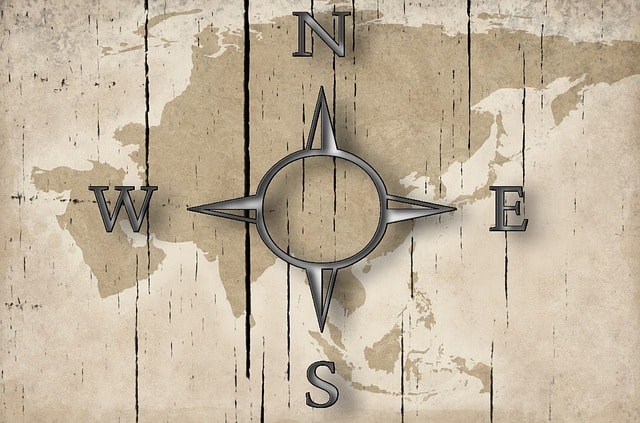I was driving home one night and thought about ancient navigators finding there way all over the world. We keep finding out they were more places than the history books have even documented yet. So, how did they get around without a GPS?
Because if you can find Polaris the North Star, you can identify where you are and where you are heading. Mariners in the past could find and realize where they were by how high or low the North Star was in the horizon. They knew where they were headed by the degree, or angle Polaris was to their ship. To be more accurate they used a tool called a Sextant.
Do We Still Need the North Star Polaris?
Throughout ancient history, navigators have always used Polaris, the North Star for direction in their travels. Not only that, your position north or slightly south of the equator can also be determined by locating it in the night sky. Because of this, one can say that it is the most important star in the night sky.
 Today, there are much more effective tools than a Sextant. Click here to see a modern take on a sextant from Amazon. Nowadays when finding the North direction, the simplest being a compass. And who hasn’t used the Global Positioning System or GPS that can very accurately determine your latitude, longitude, and altitude anymore? So why bother learning how to find Polaris, the North Star?
Today, there are much more effective tools than a Sextant. Click here to see a modern take on a sextant from Amazon. Nowadays when finding the North direction, the simplest being a compass. And who hasn’t used the Global Positioning System or GPS that can very accurately determine your latitude, longitude, and altitude anymore? So why bother learning how to find Polaris, the North Star?
For one thing, when you are finding Polaris, the North Star, you are taking part in a tradition that has helped navigators find their way around the world for thousands of years. Also, being able to find it and know where North is without a compass can be considered a valuable survival skill. But most importantly, for someone doing astronomy as a hobby, it is one of the most basic skills that you must have. The North Star is precious for locating other heavenly bodies in the night sky because it is the only star that does not change its position, and that gives us telescope users a reference point for the cosmos. Just like old navigators with a sextant we can find anything once we find Polaris.
The Facts About Polaris the North Star
Polaris is called the North Star because it is lined up with our north celestial pole. Because of this, it will appear as if it is not moving across the night sky, unlike the other stars. More specifically, all the other stars will look to pivot around it. Its name, Polaris, comes from the Latin word, stella polaris, which means “pole star.” This star is also called Alpha Ursae Minoris and is a part of the constellation of Ursa Minor, the Little Bear. It is located at the end of the Little Dipper, from which the bear is derived.
Polaris is located at a distance of 434 light years from the Earth. It is classified as a Cepheid Variable Star. A variable star refers merely to a star that changes its brightness whether it happens in a fraction of a second or within years. A Cepheid Variable Star has a brightness of around 500 to 300,000 times greater than the sun and has a short period of change that ranges from 1 to 100 days. Specifically, Polaris is 4,000 times brighter than the sun and has a period of transition that lasts for only 4 days.
Is Polaris the Brightest Star in the Night Sky?
It is a common misconception that Polaris is the brightest star in the night sky. Actually, it is not even close to being the brightest. It is only ranked as the 48th brightest star in the night sky. This title actually belongs to Sirius (Alpha Canis Majoris), or more commonly known as the “Dog Star”.
Is Polaris Located Exactly Due North?
 The axis of the Earth’s rotation is not fixed but instead wobbles in the same way that a spinning top may do. This is called precession. One complete precession takes about 26,000 years to complete. This means that the title of being the North Star passes on from star to star. When the Egyptians were still building the pyramids, a star called Thuban in the constellation Draco the Dragon was the North Star. In the year 3000 AD, Polaris will be replaced by a star called Alrai as it will then be closer to the North Pole axis.
The axis of the Earth’s rotation is not fixed but instead wobbles in the same way that a spinning top may do. This is called precession. One complete precession takes about 26,000 years to complete. This means that the title of being the North Star passes on from star to star. When the Egyptians were still building the pyramids, a star called Thuban in the constellation Draco the Dragon was the North Star. In the year 3000 AD, Polaris will be replaced by a star called Alrai as it will then be closer to the North Pole axis.
However, did you know that even with the Earth’s precession, the location of Polaris tells you the north direction more accurately than a compass? The compass is susceptible to periodic variations because it depends on the magnetic field produced by the Earth’s molten metal core. Also, the compass has an inherent error because the Earth’s magnetic North pole is not exactly in the same position as the actual North Pole. The difference in angle between the north direction showed by a compass and the direction towards the actual North Pole is called the magnetic declination. You can determine the value of magnetic declination at any location around the world to correct the readings from a compass.
How Do You Find Polaris in the Night Sky?
To find Polaris, you will first have to be familiar with the Big and Little Dipper constellations. It is actually located in the constellation of Little Dipper, but the stars in this constellation are quite faint and are difficult to find. Fortunately, the Big Dipper which is much brighter and easy to find can point us towards the location of Polaris.
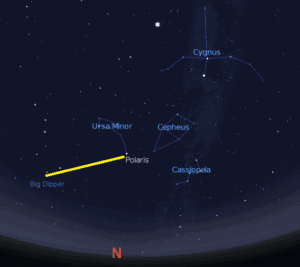 When you have located the Big Dipper constellation, you will have to direct your attention to the two “pointer stars” Dubhe and Merak. These two stars outline the outer part of the Big Dipper’s bowl. (the stars your lips would touch if you were slurping soup from the dipper) Now, draw an imaginary line from Merak through Dubhe. This line points to the direction of Polaris, around 5 times the distance of this line is how long it is away.
When you have located the Big Dipper constellation, you will have to direct your attention to the two “pointer stars” Dubhe and Merak. These two stars outline the outer part of the Big Dipper’s bowl. (the stars your lips would touch if you were slurping soup from the dipper) Now, draw an imaginary line from Merak through Dubhe. This line points to the direction of Polaris, around 5 times the distance of this line is how long it is away.
The location of Polaris on the night sky depends on your location’s latitude. It appears higher as you move farther and farther northward. In the North Pole, Polaris will appear directly overhead.
Are There Other Ways to Find Polaris?
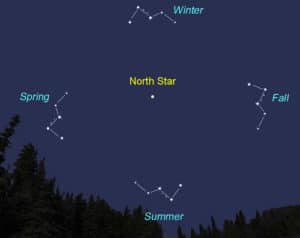
I have always been able to find the big dipper, so that is the way I use, but what other ways are there. Well, Polaris can also be located using the Cassiopeia constellation. This constellation consists of 5 stars that resemble an “M” or a “W” depending on the time of the year it is. The 3 stars that form the middle portion of the “M” or “W” points to the direction of Polaris. Just follow this direction, and you will eventually land on it. Also, you can create an imaginary line across the bottom stars (imagine it as a “W”) then create a second imaginary line from the left star and draw your imaginary line on a 90-degree angle until you reach the North Star.
The location of Polaris will also be shown on star maps or star atlases. It provides you with a map of the night sky for different regions and time of the year that can show you exactly where to look in the night sky to see Polaris. Click the picture for the star map I use to see it at Amazon.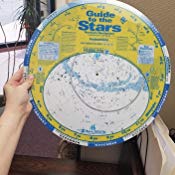
Is There a South Star?
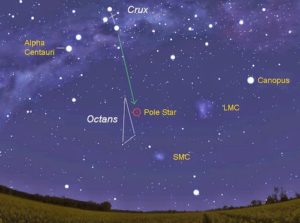
The star Sigma Octantis is currently the closest star in the night sky to the South Pole, but it is not as visible as Polaris is. That makes it hard to use for navigational purposes. It is located below the Southern Cross constellation. Just find the Southern Cross make an imaginary line continuing the vertical portion of the cross, go about 4 times the length of the 2 stars that represent the vertical portion of the Southern Cross. The just to the left there will be a faint star, the Southern Star will be the one that moves the least through the night.
Need More?
If you liked this article and would like to know more about the Constellations click here.
Other articles you may like:


